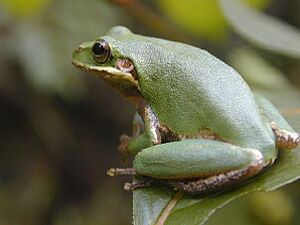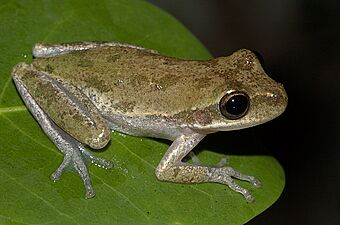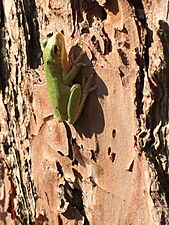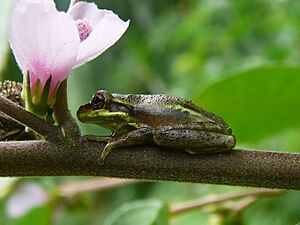Squirrel tree frog facts for kids
Quick facts for kids Squirrel tree frog |
|
|---|---|
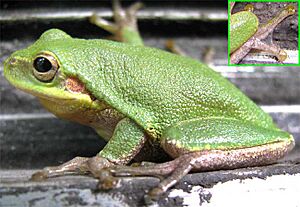 |
|
| Conservation status | |
| Scientific classification | |
| Synonyms | |
|
The squirrel tree frog (Dryophytes squirellus) is a tiny tree frog. You can find it in the southeastern United States, from Texas to Virginia. It has also been brought to the Bahamas. These frogs are small, growing to about 1.5 inches long. They come in many colors. Most are green, looking a lot like the American green tree frog. They can also be yellow or brown. Sometimes they have white or brown spots.
Contents
What Eats Squirrel Tree Frogs?
When squirrel tree frogs are young, called tadpoles, many animals try to eat them. These include dragonfly nymphs, giant water bugs, fish, and newts. Once tadpoles grow into frogs, their predators change. Now, small mammals, other frogs, snakes, and birds might hunt them.
Tadpoles hide in thick plants to stay safe. This helps them avoid being eaten. For adult frogs, their small size helps them hide. They can also change their skin color to blend in. When not looking for food, they stay hidden. They usually hunt for food close to their hiding spot.
What Do Squirrel Tree Frogs Eat?
Young tadpoles eat tiny bits of food. They scrape organic and inorganic matter from rocks, plants, and logs. Adult squirrel tree frogs are very good hunters. They eat insects and other small creatures.
People have seen them near porch lights at night. They catch bugs that are drawn to the light. They also circle fresh cow dung to eat the small flies there. Scientists have looked inside their stomachs. They found beetles, crayfish, spiders, crickets, and ants. What these frogs eat depends on where they live. It also depends on the weather and how old they are.
Where They Live and How They Reproduce
Squirrel tree frogs live in the southeastern United States. You can find them from Virginia to eastern Texas. They are also common in South Carolina and Georgia. Recently, they were introduced to the Bahamas. They live in many places. This includes fields, city areas, swamps, and forests. They can be found on the sides of buildings. Basically, anywhere with food, water, and shelter works for them.
They go back to wet areas to lay eggs. These spots are often temporary pools or ditches. These places are safe from fish that might eat their eggs. Breeding happens mostly after it rains. Female frogs lay their eggs one by one or in pairs. They can lay up to a thousand eggs. Male frogs have a special call for breeding. You can hear it from March to August. Sometimes it lasts into the fall. They gather in large groups to breed in the summer.
Protecting Squirrel Tree Frogs
Squirrel tree frogs are always active, even when predators are around. They live in both open and heavily wooded wetlands. They survive better in water with lots of plants. Because they are so active, tadpoles can be eaten by many types of fish. Adult frogs can be eaten by the non-native Cuban tree frog.
Tadpoles grow and develop quickly. This helps them survive insect predators better than fish predators. Some fish, like Gambusia holbrooki, can hunt tadpoles even in thick plants. Since tadpoles swim throughout the water, many fish can catch them.
The Cuban tree frog is known to eat smaller native frogs. This includes the squirrel tree frog. As Cuban tree frogs have increased in Florida, squirrel tree frog numbers have gone down. When raised with Cuban tree frogs, squirrel tree frogs have a lower survival rate. However, Cuban tree frogs do not seem to harm squirrel tree frog tadpoles.
Even though their numbers have dropped in some cities, squirrel tree frogs are still common in other areas. For example, they are abundant in Augusta, Georgia, and Tampa, Florida. They cross roads at night after rain. We don't know how much traffic affects their population.
The squirrel tree frog has a large population. It can also adapt to places changed by humans. Because of this, there are few worries about their conservation status. However, climate change could affect their breeding. Long dry periods reduce the temporary wetlands these frogs need to lay eggs.
Gallery
-
Squirrel tree frog on a tree in Osceola National Forest, Florida



